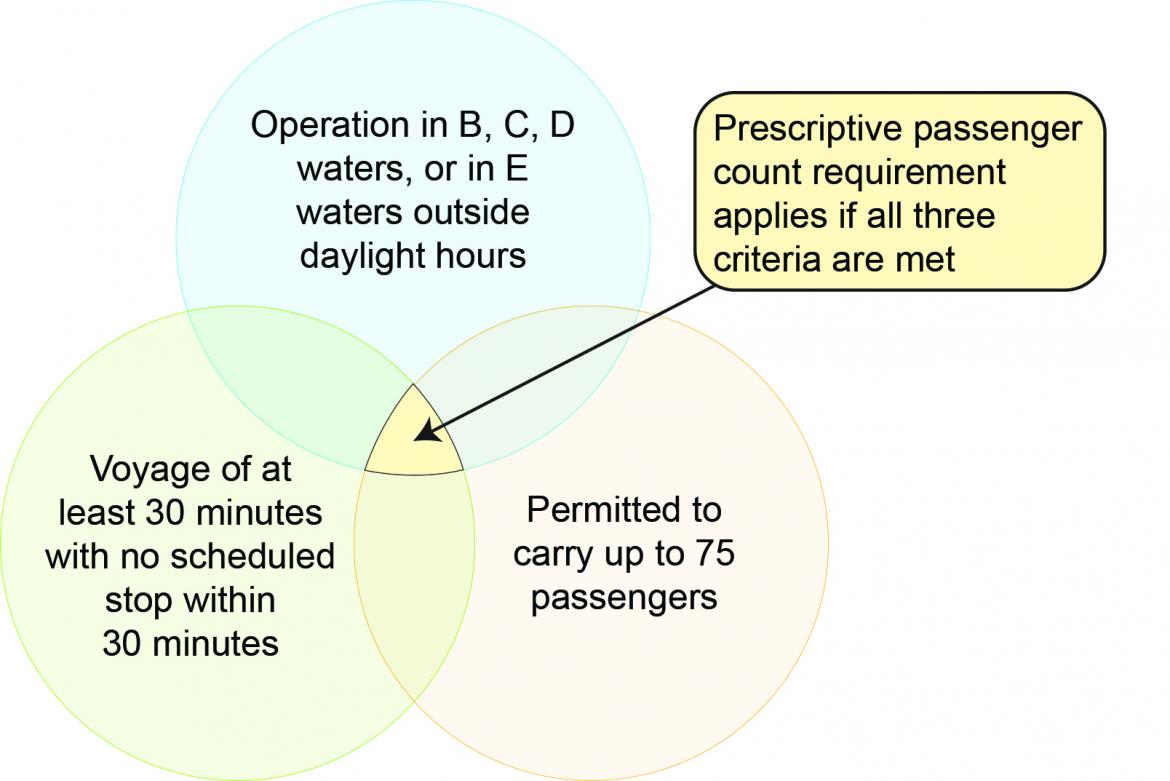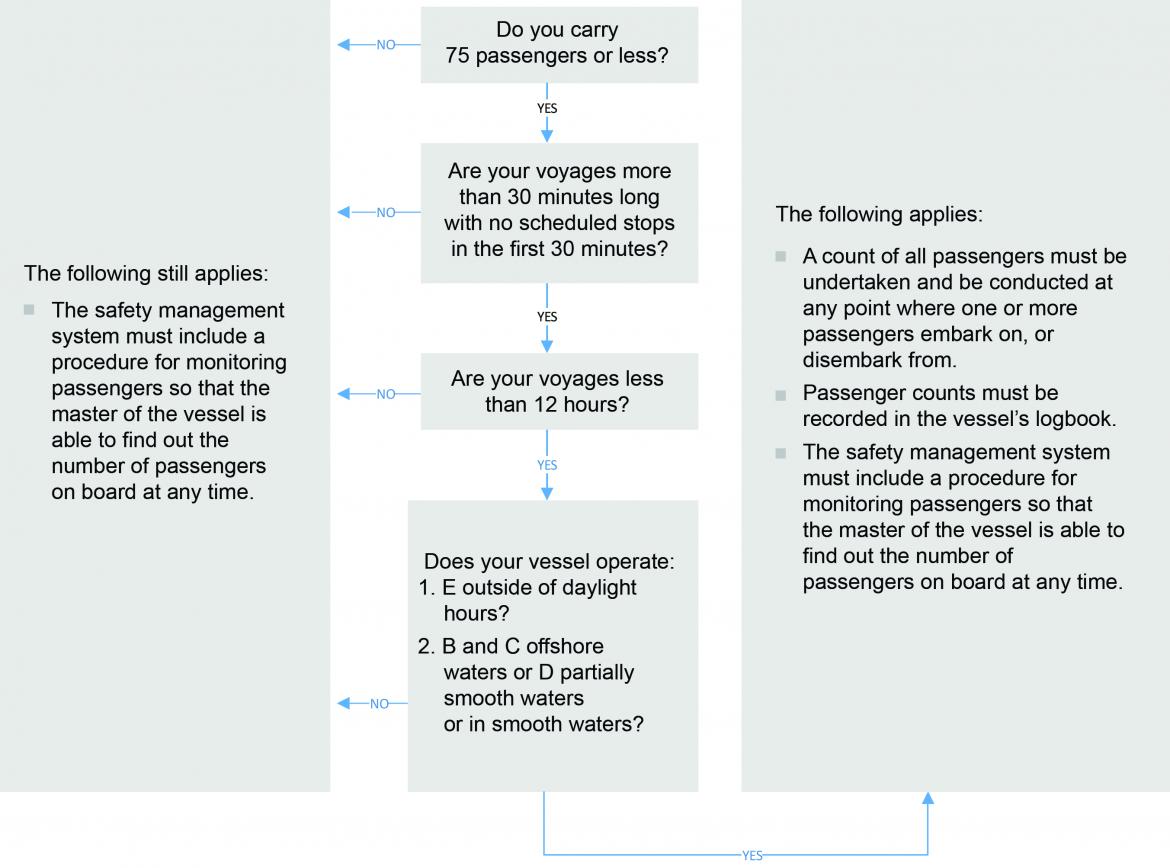On this page:
Video overview
Watch a quick overview of the requirements.
- Transcript
Thousands of passengers travel on commercial vessels every day for recreation and work. If you own or operate a commercial vessel the safety of your passengers is your highest priority.
From the 31st of May 2020 the Australian Maritime Safety Authority made some changes to legislation to improve safety on vessels carrying passengers.
Your job out on the water keeps you busy, but passenger safety management doesn't have to be complicated. It should be tailored to your operation. And can make use of technology and best practice. Have a procedure for counting and monitoring passengers and record your passenger counts in your logbook.
If your vessel is certified to carry 75 or less passengers and travels for more than 30 minutes without scheduled stops, count your passengers as they get on and off at every stop. Not just at the start and end of the voyage.
Have a procedure for a situation where a passenger is unaccounted for and make sure your crew know what to do.
Count your passengers. After all, they are counting on you.
Requirements under the national law
If you carry passengers on your domestic commercial vessel, you must meet passenger safety requirements under Marine Order 504 (Certificates of operation and operation requirements - national law) Amendment 2020.
To comply as a passenger vessel operator, you must:
- have a procedure in your safety management system (SMS) that provides an effective and verifiable means of passenger monitoring to ensure the master of the vessel is able to find out the number of passengers on board the vessel at any time.
- have an emergency procedure in your SMS for responding to a situation where a passenger is unaccounted for.
- for certain types of operations, have a procedure for counting passengers at specified points to ensure an accurate number of passengers embarking and disembarking the vessel. This includes a count:
- at or around the time passengers embark and disembark the vessel at the start and end of a voyage, or at an intermediate stop, and
- before departing any point where passengers have disembarked for a water activity such as diving, snorkelling or swimming
- record passenger counts in the vessel's logbook.
There is a community expectation that the safety of passengers has been considered before they get on board your vessel.

The flowchart below will assist in determining what your vessel is required to do in relation to passenger monitoring and counts.

Review your safety management system
All commercial vessels, including passenger vessels, should already be operating under Marine Order 504. Your passenger vessel operation must:
- Include a procedure for monitoring passengers so that the master of the vessel is able to find out the number of passengers on board at any time.
- For certain types of operations, undertake a count of all passengers on board the vessel on embarkation and disembarkation.
- Record all passenger counts in the vessel’s logbook.
- Your SMS must include information on when passenger counts will be conducted, particularly when passengers join the vessel, the vessel stops for water activities such as snorkelling, diving and swimming, and at the end of a voyage
You should already do these things and have these measures in your SMS. If so, keep doing what you’re doing and review your Safety Management System periodically. If not, here’s some further advice on how to bring your SMS up to scratch.
Risk Assessment
Your risk assessment is a critical component of an effective SMS. This should be reviewed to identify risks to passengers on board, including the risks of persons overboard under various operating conditions. Effective control measures should be identified to mitigate and manage these risks. This may mean alternative ways to monitor passenger movements such as increased monitoring or restricting access to areas that increase the risk of a person going overboard.
Other important aspects to consider are:
- Passenger briefings and encouraging passengers to look out for fellow passengers.
- Wearing of lifejackets.
- The responsible service of alcohol.
- Crewing numbers for various operating scenarios—such as parties and other events.
- How passengers will embark and disembark at the start, finish, or during the voyage.
See AMSA Safety Alert 1/2020: Safe access for vessels and AMSA Safety Alert 1/2021 Recommendations from the investigation into the loss of the passenger vessel Conception.
Emergency procedures
You must have a system in place to respond in the event of a missing passenger. For example, you should identify how you will quickly muster and account for all persons on board and determine where and when the passenger went missing. This may include, for example, verifying that a passenger is in fact missing, by repeating a count, counting by a different method, making announcements, asking passengers to check on their companions. It should also include what happens when it is more certain that someone is missing, for example, alerting rescue authorities, marking the last position, stopping the vessel or searching the water.
Passengers should also know how to alert the crew if they believe someone has gone missing.
Your SMS must also include emergency procedures for other situations:
- a personal injury or other medical emergency
- person overboard
- adverse weather or water conditions
- fire, collision, grounding, flooding, loss of steering or the master being incapacitated.
Assembly stations are also identified in the SMS, and information on emergency procedures is required to be displayed at assembly stations, in passenger cabins and other areas frequented by passengers.
Regular drills should be carried out to test the effectiveness of your emergency plans.
Knowing what you need to do in an emergency prevents confusion and makes a real difference in effectively dealing with a situation. Drills should be logged, and discussed with your crew to ensure ongoing learning, with any amendments recorded in your SMS.
Crewing assessment
Many vessels carry out a variety of passenger operations from regular sightseeing cruises, bespoke charters or tourism activities like fishing, snorkelling or whale watching. There is a community expectation that these events have been well planned, and the safety and wellbeing of passengers is considered. This includes having the appropriate number of qualified crew to ensure these events are both fun and safe.
An appropriate crewing assessment is required as part of your SMS which considers each operational scenario.
A multi-purpose operator will have different crewing requirements depending on the type of activity being carried out, for instance, sight-seeing versus conducting adventure events like diving or a private social function after dark where alcohol is served.
Assess the risk of each scenario and indicate how many crew you require to keep passengers safe. Document this in your SMS.
In the event of an incident, your crewing assessment may be requested by AMSA and any other investigating regulator or law enforcement body.
Passenger count requirements
To implement the passenger count requirements, your SMS must include a procedure on the counts that will be done. Passenger counts must be recorded in the vessel’s logbook. This can be done manually or electronically. The logbook must be available on board the vessel.
In addition to passenger counts, you must also have a procedure that sets out how you will monitor passengers so that the master is able to find out at any time how many passengers are on the vessel. There are many different ways (and combinations of ways) of achieving this, including:
- electronic monitoring
- CCTV
- electronic ticketing
These processes must be documented in the Safety Management System, and crew trained and assessed as competent to complete these tasks.
Counting passengers ‘at or around the time of embarkation or disembarkation’ does not have to be done literally at the point a passenger crosses from vessel to wharf. For example, it could be done within the first or last few minutes of a voyage, or it could be done at a muster point on land just after passengers have disembarked. The outcome must be an accurate record of the number of passengers embarking and disembarking the vessel.
Think about what is practical and effective for your particular operation. For example, it’s not practical and effective to count passengers who have disembarked onto a busy multi-user wharf, and it would be more practical and effective to count them just before arrival.
General safety duties apply to passengers as well
Passengers are expected to comply with the vessel’s safe operating procedures and can be held accountable for any behaviour that jeopardises their or anyone else’s safety.
Passengers have a responsibility to behave safely while on board. Effective signage is also an effective way to alert passengers of any risks on a vessel. You can order any of our free passenger safety decals for your vessel online.